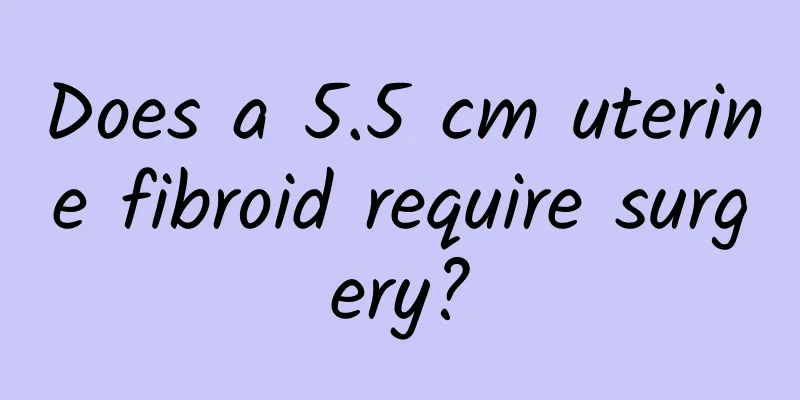Does a 5.5 cm uterine fibroid require surgery?

|
Whether a 5.5 cm uterine fibroid requires surgery depends mainly on its location and symptoms. Generally, fibroids of this size may require surgery to avoid potential health effects. 1. Symptoms and effects: Symptoms of uterine fibroids vary. Some women may not feel any discomfort at all, while others may experience anemia, frequent urination, constipation, menstrual disorders, and other problems. These symptoms are usually closely related to the size, location, and growth rate of the fibroids. If the fibroids press on the bladder or intestines, it may cause frequent urination or constipation; if it affects the endometrium, it may cause menstrual abnormalities. 2. Types of fibroids: Uterine fibroids can grow in different parts of the uterus and are mainly divided into three types: intramyometrial, subserous, and submucosal. Intramyometrial fibroids are the most common, while subserosal fibroids grow outside the uterus and may affect other organs. Submucosal fibroids grow below the endometrium and usually have a greater impact on menstruation. For 5.5 cm fibroids, the specific surgical method will vary depending on the location of their growth. 3. Surgery selection: The choice of surgery depends mainly on the location of the fibroids and the severity of the symptoms. For intramyometrial or subserous fibroids, minimally invasive surgery or laparotomy can be selected for removal. If the fibroids are located under the mucosa, surgical removal under hysteroscopy is usually required. These surgical methods have their own advantages and disadvantages. The specific choice requires full communication with the doctor and a decision based on personal health status and fertility plan. 4. Benign characteristics and risks: Although most uterine fibroids are benign tumors and are related to elevated estrogen levels, this does not mean that they can be taken lightly. Fibroids that are not treated for a long time may continue to grow and cause more serious symptoms or complications. Although the risk of malignant lesions is low, regular monitoring and timely treatment are still wise. 5. Lifestyle and prevention: Although the exact cause of uterine fibroids is not yet fully understood, a healthy lifestyle may help reduce the risk. Maintaining a healthy weight, a proper diet, moderate exercise, and regular physical examinations are all effective measures to maintain uterine health. Active preventive measures are particularly important for women with a family history or other risk factors. Whether a 5.5 cm uterine fibroid requires surgery depends on a variety of factors, including symptoms, location of the fibroid, and personal health. Timely medical attention and communication with doctors are key steps to ensure health. Through scientific diagnosis and treatment plans, women can effectively manage uterine fibroids and maintain a healthy life. |
<<: Is 3D color Doppler ultrasound accurate for intrauterine adhesions?
>>: Is chronic cervicitis serious?
Recommend
Expert analysis: What are the symptoms of menstrual disorders?
Expert analysis: What are the symptoms of menstru...
Pelvic inflammatory disease prevention and care
Pelvic inflammatory disease is often divided into...
8 steps of massage before bed to create supermodel-like slender legs
"The most difficult part of losing weight is...
What causes miscarriage? Listen to the doctor
During pregnancy, you should pay more attention t...
Eat this way to fight cancer, nourish and strengthen your body! Nutritionist demonstrates how to make "Mushroom Chicken Soup" for lunch to replenish nutrition and energy
Delicious and rich soups not only have rich and d...
There are several manifestations of the harm of endometrial tuberculosis
Endometrial tuberculosis has certain hazards, whi...
Long-term use of drugs can cause irregular menstruation
Menstruation is an external manifestation of the ...
How to prevent and treat cervical hypertrophy?
Many women have a certain degree of panic and don...
Do you have back pain from sitting or standing for a long time? 4 "Year-End Success Exercises" to Keep Your Bones Healthy
Xiaohui is a sedentary office worker who stares a...
Experts introduce common sense of care for vulvar leukoplakia
Patients with vulvar leukoplakia must do a good j...
What is the reason for women’s scanty menstruation?
What is the reason for women’s scanty menstruatio...
Do I need to stay in bed for a month after having an abortion? What are the dangers of having an abortion?
Abortion is extremely harmful to women's heal...
Introduce the hazards of three-point cervical erosion
What are the dangers of cervical erosion? This is...
To lose weight, you need to avoid body fat accumulation. You must eat berry fruits to get rid of the fat around your waist!
Have you tried many ways to lose weight, but stil...
Does pelvic effusion affect the fetus?
Does pelvic effusion affect the fetus? This is a ...









